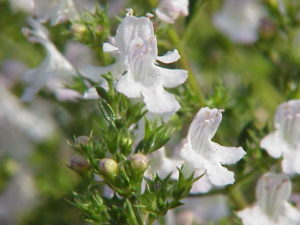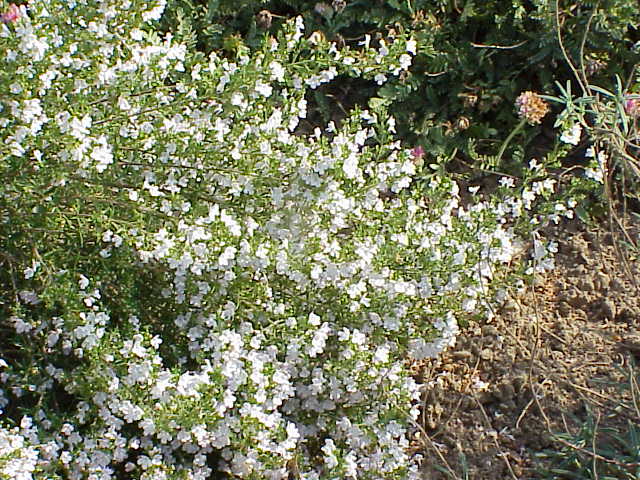
Winter savory flowers
Winter savory (Satureja montana) is a woody perennial native to the areas surrounding the Mediterranean. It is also called “mountain savory” reflecting its origins in the mountains. Winter savory is primarily a culinary herb with a flavor stronger than summer savory, an annual from the same region. The flavor mellows with longer cooking times. It is most often used with strongly flavored meats such as game meats. Winter savory is often mixed with thyme, oregano and basil.
Winter savory has also been used medicinally to treat gastric disorders, menstrual disorders and cystitis. A medical grade form of the essential oil has been shown to be effective against Candidiasis, a fungal growth in the mouth common among patients with compromised immune systems.
In the vegetable garden, use winter savory as a companion plant with your beans. It repels bean weevils. You can also use it as a companion plant for roses where it will repel aphids and discourage the growth of mildew.
In the herb garden, winter savory is often used as a border plant due to its petite size and ability to be formally pruned like a hedge.
The plants are hardy in zones 5 through 8. They grow to about a foot tall in well-drained soil and full sun. The flowers are white or lavender and smaller than summer savory. Bloom time is between July and October.
Although most people purchase winter savory as plants, it is easy to grow from seed. You can direct sow the seed in your garden in the spring or fall. Surface sow them. They need sunlight to germinate.
Alternatively, you can start your seeds indoors 6 to 8 weeks before your last frost. Lightly tamp the seeds on the surface of your planting medium. Do not cover them. They need light to germinate. They also need warmth. Soil temperature should be 70⁰F to 75⁰F. A heat mat helps. Germination should occur in 1 to 3 weeks. Be patient. Perennial seeds take longer to germinate than annual seeds. You can transplant your seedlings into your garden after all danger of frost has passed. Space them 8 inches apart in rows 12 to 18 inches apart. If you are using the plants as an edging, you will want to plant them a little closer together.
Harvesting is usually done when the plants are in flower, but it can begin as early as when the plants reach six inches in height. For best flavor, harvest new shoots and leave the older woody stems. You can cut the entire plant down to the ground several times during the growing season to encourage new, tastier growth. In the fall, the plants lose their leaves but do not cut the bare branches back. Leave them because the plant will start growing from those branches in the spring.

